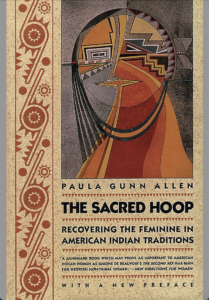In her book, The Sacred Hoop: Recovering the Feminine in American Indian Traditions, Dr. Paula Gunn Allen writes that prior to 1800, matrifocal systems were the primary ways of ordering communities among most Native American Peoples. She describes the nature of life among these communities where the focus was on responsibility towards and acceptance of the diversity of fellow community members “rather than on denial-based social fictions to which human beings are compelled to conform by powerful individuals within the society” (p. 3).
 Much like maternal gift economies the world over (Vaughan, 2007), cooperation and sharing were primary values, resulting in a largely egalitarian distribution of food and provisions. After all, everyone was considered a child of the First Mother. Central to the community was the welfare of the young, the complementarity of all life forms, and women’s role in maintaining community welfare.
Much like maternal gift economies the world over (Vaughan, 2007), cooperation and sharing were primary values, resulting in a largely egalitarian distribution of food and provisions. After all, everyone was considered a child of the First Mother. Central to the community was the welfare of the young, the complementarity of all life forms, and women’s role in maintaining community welfare.
“As many Indians see it is that women who are at the peak of their fecundity are believed to possess power that throws male power totally out of kilter. They emit such force that, in their presence, any male-owned or -dominated ritual or sacred object cannot do its usual task.” (p. 47)
“A strong attitude integrally connects the power of Original Thinking or Creation Thinking to the power of mothering. That power is not so much the power to give birth, as we have noted, but the power to make, to create, to transform. Ritual, as noted elsewhere, means transforming something from one state or condition to another, and that ability is inherent in the action of mothering.” (p. 29)
Such women-centered, egalitarian cultures govern by consensus to promote health and maintain cooperation. They care for all children and old people. No child is illegitimate and there are no orphans. Noticeable and shocking to European missionaries and settlers was the absence of punishment to control children. Instead, they strive to maintain peaceful harmony and general prosperity, of humans and non-humans. Because every creature shares in the process of ongoing creation, all entities are considered sacred.
“At base, every story, every song, every ceremony tells the Indian that each creature is a part of a living whole and that all parts of that whole are related to one another by virtue of their participation in the whole of being.” (p. 60)
She points out that the lifeways of American Indians are rooted in a dynamic self-esteem in contrast to the Christian lifeways that are rooted in a sense of separation and loss. American Indians traditionally maintain and honor a holistic worldview of intertwined manifest (visible, material) and unmanifest (Spirit) aspects of the universe. This contrasts too with English-speaking people who separate natural and supernatural and both from human existence, making for lonely isolation and alienation from the rest of Life.
Among American Indian communities, the power of imagination was actualized into ways of being and living.
“The old ones were empowered by their certain knowledge that the power to make life is the source and model for all ritual magic and that no other power can gainsay it. Nor is that power really biological at base; it is the power of ritual magic, the power of Thought, of Mind, that gives rise to biological organisms as it gives rise to social organizations, material culture, and transformations of all kinds—including hunting, war, healing, spirit communication, rain-making, and all the rest.” (p. 28)
Following European settler-colonization, there was a double whammy on American Indian communities—by governments and by religion. Government policies forced an alteration in external practices like food gathering, child raising, religious practices, and laws. (She does not mention residential schooling and kidnapping that took place in Canada and the USA to break down American Indian culture and community.) Traditional “internal practices” like healthy self-esteem, self-confidence and a Spirit-governed internal moral compass were altered by Christianity.
Restoring the evolved nest and the Indigenous or Kinship worldview are vital for regenerating societies that feel connected and responsible for the wellbeing of all.
Paula Gunn Allen (1939-2008) was a novelist, poet and pioneer in Indigenous feminist studies.
Bibliography
Adams, D.W. (2020). Education for extinction: American Indians and the Boarding School Experience, 1875-1928, 2nd ed. University Press of Kansas.
Allen, Paula Gunn (1986). The Sacred Hoop: Recovering the Feminine in American Indian Traditions. Beacon Press.
McPherson, D.H., & Rabb, J.D. (2011). Indian from the inside: Native American philosophy and cultural renewal, 2nd ed. Jefferson, NC: MacFarland & Co.
Narvaez, D., & Bradshaw, G.A. (in press, August 2023). The Evolved Nest: Nature’s Way Of Raising Children And Creating Connected Communities. North Atlantic Books.
Topa, W. (Four Arrows), & Narvaez, D. (2022). Restoring the Kinship Worldview: Indigenous Voices Introduce 28 Precepts for Rebalancing Life on Planet Earth. North Atlantic Books.
Vaughan, G. (Ed.) (2007). Women and the Gift Economy. Toronto: Ianna Publications.

